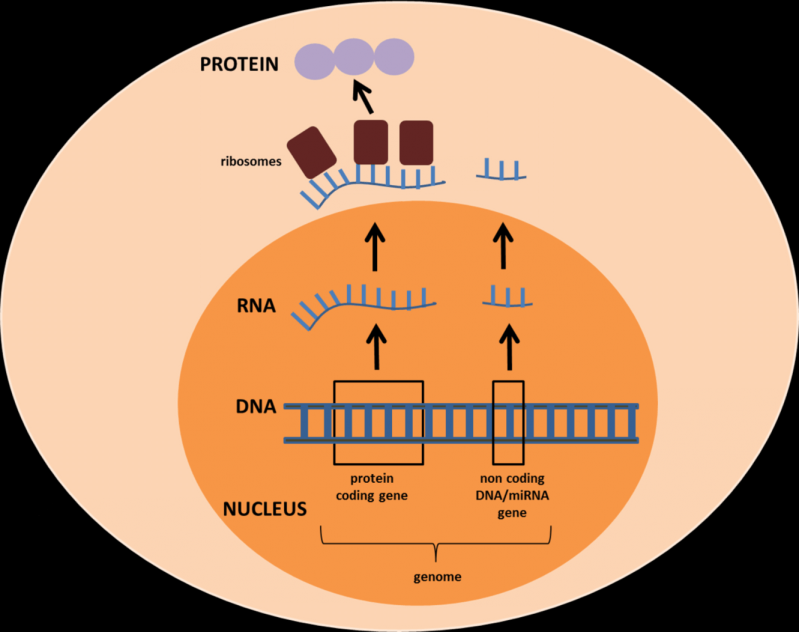MicroRNA, the puppet master of the genome

We all know how irritating it is to have an inbox flooded with junk mail. Fortunately email providers these days contain filters to keep the junk mail at bay. As a result the junk mail folder tends to pile up with never-to-be-read emails.
But, occasionally, an important email is snagged by the filter and is unduly ignored.
We can think of the human genome as a server sending out a constant bombardment of emails. These messages are on average 2,000 letters long, and these "letters" are made up of different types of bases, some of which are packaged in the form of RNA.
Up until about two decades ago, one type of RNA, called microRNA, or just miRNA – by virtue of them being very short, only 18-25 letters long – were thought to be the junk mail of the genome, with no biological function. But today we know that these miRNA are actually not junk but play a very important role in regulating the activity of other parts of your DNA.
Centra dogma
The discovery of the structure of DNA in 1953 by American biologist James Watson and English physicist Francis Crick is one of the most significant discoveries in scientific history.
This discovery spawned the field of molecular biology. From this came the "central dogma" that our genetic information is stored as a DNA code, which is then converted into an RNA message (mRNA).
The tiny protein factories, ribosomes, then read the mRNA. These decode the messages and create proteins, which are the workhorses of biology. All of this activity is constantly taking place within our cells and it all starts from the genome.
Your genome contains all the instructions a cell needs to function in the form of our 20,000-odd genes. But, surprisingly, these genes only make up around 2% of our entire genome. So the question is: what does the remaining 98% of our DNA actually do?
Resetting our junk mail filters

For biologists, those important emails that slipped into the junk mail folder and were disregarded were miRNAs. That was until the first functional miRNA, lin-4, was officially discovered in 1993. Scientists were looking at the development of the nematode worm, Caenorhabditis elegans, and found that lin-4 inhibited protein synthesis of the lin-14 gene.
They subsequently found that miRNA can physically bind to mRNA and stop it creating proteins. Thus it effectively suppresses the activity of a gene. This discovery was the first evidence of miRNA negatively regulating RNA coding for proteins.
So, it turns out that the 98% of our genome that was regarded as "junk" might have a function after all.
The second miRNA was not discovered for another seven years. But since then, more than 1,800 human miRNAs have been found. We now understand that miRNA control numerous genes and processes vital for cellular life such as metabolism, development and the immune system.
While two decades ago genes and proteins were seen as the most important players in what happens in our body, miRNAs are now recognised as the puppet masters, pulling the strings of various genes on the molecular biology stage.
miRNA and cancer
One promising application of miRNAs is their potential as biomarkers and therapeutics in cancer.
A 2002 study found two miRNAs were deleted in 68% of chronic lymphocytic leukemias. It is quite common for cancers to strategically stifle parts of the genome where tumour suppressor genes are located. Interestingly, the researchers found that these regions often encoded miRNAs, hence they found a strong association between miRNA and cancer.
One fascinating aspect of miRNA is that they control 60% of the genes in the human genome. The secret lies in their promiscuity. One miRNA can bind to many mRNAs and inhibit their expression. This suggests that the future of cancer therapy may lay with miRNA-based drugs that can target multiple genes, and therefore affect multiple pathways involved in cancer. This moves us on from the "one drug, one target" approach.
The therapeutic use of miRNAs in cancer is still in its infancy, although there is terrific potential. One of the main challenges is creating an miRNA which is stable without side effects.
There are some success stories so far. The two most notable being MRX34, which is an miR-34-based cancer therapy used for liver cancer, and has been shown to stop cancer cells growing. It is currently undergoing early stage clinical trials.
There is also Miravirsen, which also targets the liver, and is based on miR-122. It has shown tremendous success in liver cancer patients in mid-stage clinical trials.
The interest in miRNA in the scientific community has increased exponentially in the last few years as researchers join in the race to develop a functional and effective miRNA-based therapeutic for cancer.
Far from being junk mail, miRNAs are the commands that redirect other messages, enabling some activities to go ahead and others to cease entirely. And now that biologists have updated their filters, they're now coming to grips with how powerful miRNAs can be.
This story is published courtesy of The Conversation (under Creative Commons-Attribution/No derivatives).
![]()


















